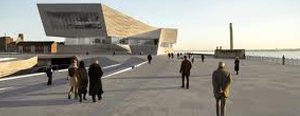 Originally, the stairs were to meet in a "valley".
Originally, the stairs were to meet in a "valley".
The Museum of Liverpool, built in 2011, is buzzing with energy this summer. With vibrant cultural exhibitions mixed with futuristic displays, the UK’s largest museum development in the past hundred years is a melting pot for all lovers of art and life.
But some of the buzz is taking place not within its contemporary walls, but around the verdict of the most senior judge in the Technology and Construction Court. In August, 2013, Mr. Justice Akenhead handed down a damning verdict against AEW Architects over serious problems in the design and construction which have plagued the iconic buildings construction since 2008.
 A concrete plinth was installed after architects and contractors realized the stairs wouldn't meet up properly. This "solution" only caused more problems.
A concrete plinth was installed after architects and contractors realized the stairs wouldn't meet up properly. This "solution" only caused more problems.
Due to a change in the steelwork design, the concrete steps and seats leading up to the first-floor entrance to the building needed a new approach then was originally planned. After attempting to find a solution, it was realized in January of 2010 that the approach had missed the mark. Not only was the plinth they had installed not what the Museum executives wanted, it was an eyesore fraught with problems:
- AEW did not specify the amount of concrete covering needed for the steel bars reinforcing the pre-cast step and seat units. Akenhead ultimately ruled that the 25 mm (1 inch) cover in the units supplied was not enough, making them, on a seafront site, susceptible to decay.
- Gaps between the backs of the steps and the rises behind them were wide enough to trap heels or fingers, constituting a safety hazard
- The waterproofing sheet membrane underneath the concrete steps was damaged and letting water into the storage room underneath.
AEW was ordered to pay damages of just under £1m along with the building’s contractor, who was
ordered to pay a further £205,000.
The Museum opened to the public regardless of these flaws, but has had to keep these areas cordoned off. With this monetary award, they are planning to finally be able to rectify the exterior issues, and open the building fully to visitors.
How could KIM have helped prevent a situation like this?
Using a crystalline waterproofing admixture, instead of an external waterproofing membrane for the concrete, has tremendous benefit to an architect by helping them achieve greater design flexibility.
By adding the waterproofing to the concrete itself, they wouldn’t need to worry about placing concrete over sheet membranes, or of the membrane breaking down or tearing.
Other benefits to architects include:
- Building to LEED standards
- Helps to keep the project on time and on budget







